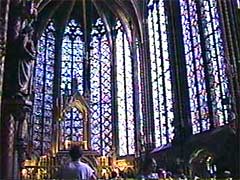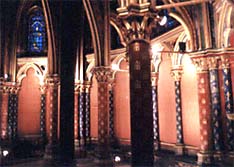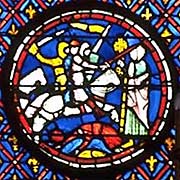The Sainte-Chapelle ("Holy Chapel"), located within
the Palais de Justice complex on the Ile de la Cité in the center of
Paris. It was erected by Louis IX, king of France, to
house the Crown of Thorns and a fragment of the True Cross, precious
relics of the Passion. Louis had purchased these in 1239 from the
Byzantine emperor Baldwin II, for the exorbitant sum of 135,000 livres (the chapel "only" cost 40,000 livres to build). Two years later, more relics were brought from Byzantium.
The original plan of the chapel dates from 1241. After breaking ground in January of 1246, the Sainte-Chapelle
was rapidly constructed, and completed April 25, 1248.
The Upper Chapel
 |
|
| Upper chapel of Sainte-Chapelle © Christopher Callahan |
|
The upper chapel was the part of the building
reserved for the king, his close friends and family, as well as for
displaying the religious relics.
The holy relics purchased by Saint Louis were kept
in a large, richly decorated reliquary, placed at the summit of the open
tribune, at the back of the apse. In addition to the Crown of Thorns and a piece
of the True Cross, the Sainte-Chapelle's collection of relics included a
number of other key pieces mentioned in both Testaments of the Bible.
 |
|
| Lower chapel of Sainte-Chapelle © Jane Raley |
|
The Lower Chapel
The lower chapel
is dedicated to the Virgin Mary, whose statue stands freely next to the
central pier of the portal. During the period of the monarchy, the lower chapel was
reserved for palace staff.
|
||
|
||
Stained Glass
Sainte-Chapelle is renowned for its richly hued stained glass windows. Two-thirds
of the pieces are original works, representing the finest examples of
12th century craftsmanship. Reds and blues are the dominant colors, in
contrast with the 15th century western rose window.
In these panes the full biblical story of humanity is recounted, from
the Creation to redemption through Christ; Genesis, Exodus, Numbers,
Deuteronomy, Judges, Isaiah, the Tree of Jesse, Saint John the Baptist,
Daniel, Ezekiel, Jeremiah, Tobias, Judith and Job, Esther, the Book of
Kings, and the History of the Relics follow one to the next. Each
window, divided into arches, reads from left to right and from top to bottom.
Following a period of disaffection for the
Sainte-Chapelle in 1803, its stained-glass windows were stored in a
two-meter space, in order to use the building as a repository for the
state's archives. They were admirably restored in the 19th century, then
carefully removed during World War II in anticipation of the German
invasion of Paris. Following the war, every piece was meticulously
replaced.
 |
| The chapel walls are essentially stained glass |
 |
| The tile floor |
 | ||||
| Located inside the Palais de Justice complex - you can see the spire |
Marché aux Fleurs et aux Oiseaux

Photograph: John Brunton
Operating for over two centuries, this is one of the last Parisianmarkets dedicated to flowers and birds. Situated on the Île de la Cité in the middle of the Seine, this is a haven of peace between the crowds of tourists that flock to nearby Notre Dame cathedral and the Conciergerie. Unlike any other Parisian marché, the flower market is open every day of the week. By contrast, it is only on Sundays that the bird traders arrive, setting up cages with everything from doves and budgies to exotic parrots and macaws.





